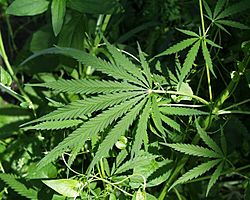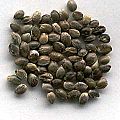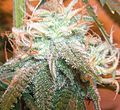Cannabis facts for kids
Quick facts for kids Cannabis |
|
|---|---|
 |
|
| Scientific classification | |
| Kingdom: | |
| Division: | |
| Class: | |
| Order: | |
| Family: | |
| Genus: |
Cannabis
|
| Species | |
|
Cannabis sativa L. |
|
Cannabis is a type of flowering plant. It is known for producing a substance called marijuana. There are three main kinds, or species, of cannabis: Cannabis sativa, Cannabis indica, and Cannabis ruderalis.
The flowers of the cannabis plant have a special chemical called THC. THC stands for tetra-hydro-cannabinol. When people use the flower, this chemical can make them feel very happy or sleepy. The plant is also used to make strong hemp fibers for things like rope and cloth. Its seeds and seed oil are also useful.
In nature, THC helps the plant protect itself from being eaten by animals. There are many different types of cannabis plants. Some types have very little THC. These are often grown to make hemp and seeds.
In many countries, marijuana is considered an illegal drug. This means it is against the law to use it. However, some countries have decided to make marijuana legal. Other countries allow cannabis to be used as medicine. This is only for people with certain health problems.
History of Cannabis
Cannabis plants have been used by people for a very long time. Scientists believe people first started growing cannabis about 12,000 years ago. This was in East Asia during a time called the early Neolithic period.
One of the oldest written records about cannabis comes from a Greek historian named Herodotus. He wrote about people called the Scythians who lived in central Eurasia. They used cannabis in steam baths.
The ancient Hindu people were also famous for using cannabis. They called it ganjika in their language, Sanskrit. Some stories say that the Indian god Shiva told his followers to worship the plant.
Cannabis use then spread across the Islamic empire to North Africa. In 1545, it came to the western part of the world. Spanish people brought it to Chile to use its fibers. In North America, cannabis was grown as hemp. It was used to make rope, cloth, and paper.
Cannabis in Beliefs and Traditions
The cannabis plant has been used for thousands of years in different cultures. It was often used for health reasons. In China, a very old grave was found. It belonged to a shaman from about 2,700 years ago. Inside the grave, there was a basket and bowl filled with cannabis. People think this cannabis was used for medicine or for telling the future.
Cannabis is mentioned in ancient Hindu texts called the Vedas. This was between 2000 and 1400 BCE. By the 10th century CE, some people in India even called it "food of the gods."
In Buddhism, cannabis is usually seen as something that can make you feel confused. It might make it harder to focus during meditation.
Cannabis is also used by some Sufis. Sufism is a special way of understanding Islam. It is common in places like Bangladesh, India, Indonesia, Turkey, and Pakistan.
Images for kids
-
Cannabis growing as weeds at the foot of Dhaulagiri, Nepal.
-
Cannabis Museum in Amsterdam.
-
Cannabis flower with tiny hairs called trichomes.
See also
 In Spanish: Cannabis (género) para niños
In Spanish: Cannabis (género) para niños














